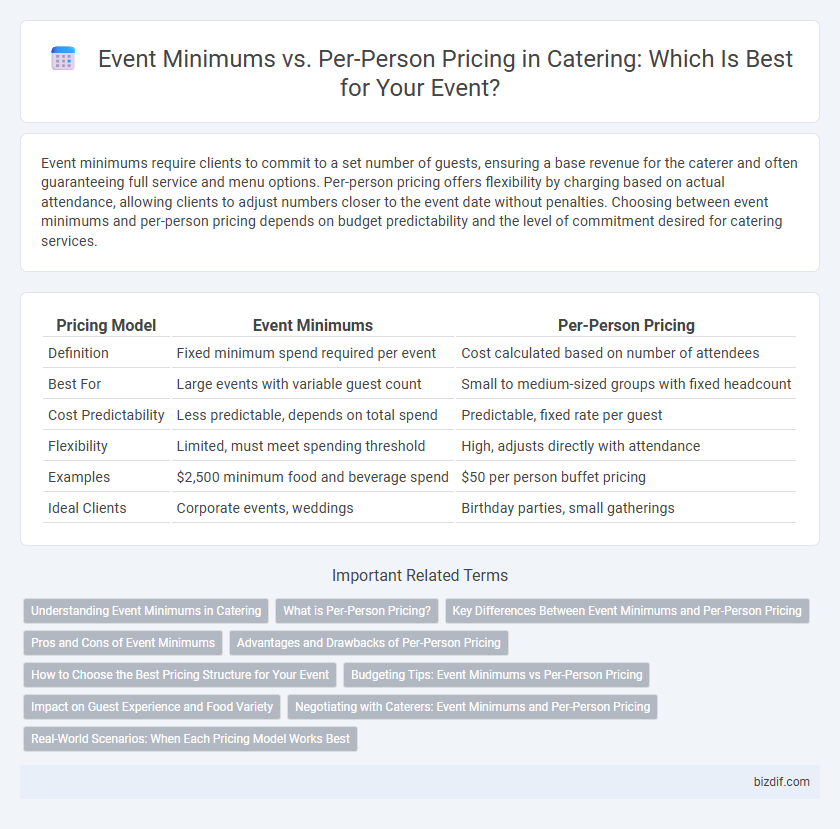Event minimums require clients to commit to a set number of guests, ensuring a base revenue for the caterer and often guaranteeing full service and menu options. Per-person pricing offers flexibility by charging based on actual attendance, allowing clients to adjust numbers closer to the event date without penalties. Choosing between event minimums and per-person pricing depends on budget predictability and the level of commitment desired for catering services.
Table of Comparison
| Pricing Model | Event Minimums | Per-Person Pricing |
|---|---|---|
| Definition | Fixed minimum spend required per event | Cost calculated based on number of attendees |
| Best For | Large events with variable guest count | Small to medium-sized groups with fixed headcount |
| Cost Predictability | Less predictable, depends on total spend | Predictable, fixed rate per guest |
| Flexibility | Limited, must meet spending threshold | High, adjusts directly with attendance |
| Examples | $2,500 minimum food and beverage spend | $50 per person buffet pricing |
| Ideal Clients | Corporate events, weddings | Birthday parties, small gatherings |
Understanding Event Minimums in Catering
Event minimums in catering establish the least number of guests required to book a service, ensuring cost efficiency and resource allocation for the caterer. This pricing structure helps prevent underutilization of staff and ingredients, maintaining quality standards while balancing operational expenses. Unlike per-person pricing that charges individually, event minimums provide a baseline commitment that can affect overall budget planning for gatherings.
What is Per-Person Pricing?
Per-person pricing in catering refers to a cost structure where clients are charged a fixed rate for each guest served, ensuring clear budget expectations and straightforward billing. This model allows for precise cost management based on the number of attendees, making it ideal for events with variable guest counts. Unlike event minimums, which require a set minimum spend regardless of attendance, per-person pricing directly correlates costs to the actual number of guests served.
Key Differences Between Event Minimums and Per-Person Pricing
Event minimums require a client to meet a set spending threshold regardless of actual guest count, ensuring the caterer covers fixed costs and operational expenses. Per-person pricing charges clients based on the exact number of attendees, offering flexible budgeting and aligning costs directly with guest count. Understanding the distinction helps clients choose the best pricing model for their event size and financial goals.
Pros and Cons of Event Minimums
Event minimums establish a baseline revenue for caterers, ensuring cost coverage for staffing, ingredients, and setup, which helps in resource planning and reduces financial risk. However, event minimums can make pricing less flexible for smaller groups, potentially deterring clients with limited budgets who may prefer per-person pricing for clearer cost expectations. Balancing event minimums with transparent communication about value and service scope increases client satisfaction while maintaining operational efficiency.
Advantages and Drawbacks of Per-Person Pricing
Per-person pricing in catering offers straightforward budgeting by providing a fixed cost per guest, which simplifies financial planning and avoids unexpected expenses. This model ensures consistent revenue and easier menu customization based on guest count but may lead to higher costs for small events due to minimum guest requirements. However, it can limit flexibility for clients with fluctuating attendance and sometimes restrict menu options, potentially reducing overall customer satisfaction.
How to Choose the Best Pricing Structure for Your Event
Choosing between event minimums and per-person pricing depends on the event size, budget, and menu variety. Event minimums guarantee a baseline spend, ideal for larger gatherings with diverse offerings, while per-person pricing provides predictable costs for smaller or more straightforward events. Analyzing guest count, menu complexity, and desired flexibility ensures selecting the most cost-effective and suitable catering pricing structure.
Budgeting Tips: Event Minimums vs Per-Person Pricing
When budgeting for catering, understanding the difference between event minimums and per-person pricing is crucial to optimizing costs. Event minimums require a fixed spend that may not align with guest count, potentially leading to higher expenses if the minimum isn't met. Per-person pricing offers precise cost control based on actual attendance, making it ideal for fluctuating guest lists and tighter budgets.
Impact on Guest Experience and Food Variety
Event minimums ensure a guaranteed number of guests, allowing caterers to plan and prepare a diverse menu that enhances food variety and quality, directly impacting guest satisfaction. Per-person pricing offers flexibility for smaller groups but may limit menu options due to cost constraints, potentially reducing the overall dining experience. Balancing minimums with per-person rates helps maintain a rich culinary selection that elevates the guest experience while managing budget expectations.
Negotiating with Caterers: Event Minimums and Per-Person Pricing
Negotiating with caterers involves understanding the balance between event minimums and per-person pricing to optimize budget and service quality. Event minimums require a set spend regardless of guest count, which can increase expenses if attendance is lower than expected, while per-person pricing offers flexibility by charging only for confirmed guests. Effective negotiation includes requesting customized packages or tiered pricing to align costs with projected attendance and ensure value without compromising on menu choices or service levels.
Real-World Scenarios: When Each Pricing Model Works Best
Event minimums work best for large gatherings where a guaranteed revenue threshold ensures efficient resource allocation and cost management, such as weddings or corporate conferences with predictable guest counts. Per-person pricing suits smaller or more variable events, like intimate parties or networking mixers, allowing clients to scale costs directly with attendance. Real-world scenarios favor event minimums when venues or caterers need to secure fixed expenses, while per-person pricing offers flexibility for fluctuating or uncertain guest numbers.
Event minimums vs Per-person pricing Infographic

 bizdif.com
bizdif.com